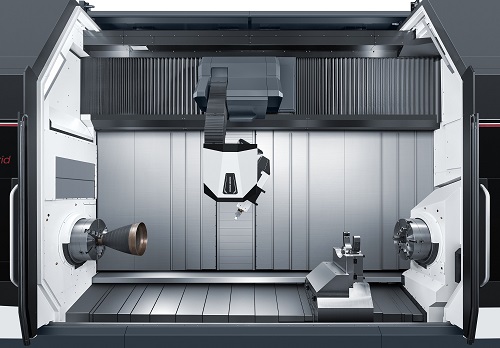Quality assurance software developer Sigma Labs has formed a “strategic alliance” with advanced manufacturing firm IN4.OS to build the “Smart Factories of the Future.”
The proposed location-agnostic facilities will deploy Sigma’s PrintRite3D technology to ensure that a farm of DMG MORI’s LASERTEC metal 3D printers fabricate parts of the highest possible quality. Through its broader Smart Factory initiative, IN4.OS now aims to provide defence and aerospace firms with a more flexible and scalable industry 4.0 alternative for producing mission critical parts.
“IN4.OS’s concept of Smart Factories of the Future is a timely and courageous response to increasing the country’s self-sufficiency in times when supply chains are disrupted,” said Mark K. Ruport, Sigma Labs’ President and CEO. “We are excited to work with IN4.OS and DMG MORI, as they take on this important initiative.”
“This triad of innovative companies will offer compelling and differentiated solutions for our domestic manufacturing capability.”
Sigma’s PrintRite3D quality assurance software
During the Smart Factories project, Sigma will deploy its proprietary PrintRite3D quality assurance software to ensure that any 3D printed components meet the high standards of demanding defense applications. The program itself allows users to monitor the progress of parts as they’re being produced, including multiple thermal parameters such as temperature or melt pool analytics.
Using the advanced software, customers are able to identify potentially defective parts in real-time, which allows users to cease production before they’re complete, saving time and materials in the process. Sigma’s system is also platform-independent, meaning that it can be applied to any 3D printing brand or process, which makes it ideal for optimizing IN4.OS’s third-party DMG MORI machines.
Given that the software can be retrofitted to existing 3D printers, it’s currently being evaluated by a number of aerospace firms, and Sigma has licensed it to various partners in recent years. In a partnership with Northwestern University and Materialise in March 2020, Sigma’s program was successfully integrated with a DMG MORI LASERTEC12 SLM machine.
Eventually, the university aims to leverage Sigma’s tool as a means of developing a range of novel manufacturing methods and alloys for 3D printing. Similarly, Sigma has signed a deal with aviation company Airbus, which saw it use PrintRite3D’s Rapid Test and Evaluation function to enter the serial production of aerospace parts.
Following the company’s latest deal with IN4.OS, Sigma plans to deploy its software to build the “factories of the future,” by ensuring that fabricated components meet the demands of high-performance sectors.

IN4.OS and Sigma’s Smart Factories
IN4.OS’s Smart Factories are “cyber-physical,” meaning that the systems can be monitored remotely to provide maximum flexibility and scalability for potential clients. Introducing Sigma’s PrintRite3D tool to these facilities will allow different types of machines to be added at will, and a unified quality control system to be applied across a number of systems.
The proposed factories are set to specifically target the aerospace and defense industries, to enable complex mission-critical parts to be printed on-demand. DMG MORI’s LASERTEC machines will be deployed in the project, as they were by Materialise earlier this year, but on a larger scale, and with the aim of addressing a broader range of applications.
According to IN4.OS’s CEO R J Singh, Sigma’s software is pivotal to the establishment of 3D printing as a conventional manufacturing technique. “Sigma Labs’ PrintRite3D is a crucial component of making additive manufacturing mainstream for critical manufacturing and delivering qualified products,” said Singh.
“We look ahead to ushering in a new era of American manufacturing with our strategic partners, Sigma Labs, and DMG MORI,” he added.
Quality assurance software in the wider industry
As 3D printed end-use spare parts continue to find applications in new industries, the demand for high-quality components has never been higher. In order to cater to this growing market, a number of firms have recently released quality assurance software, that enables fabricated objects to be closely monitored and optimized for use within specific industries.
Californian metal 3D printer manufacturer VELO3D, for instance, has released a Quality Assurance and Control System for its Sapphire line of Laser Powder Bed Fusion (LPBF) machines. Stratasys Direct Manufacturing has already implemented the system and validated its value in charting the part quality needed for high-volume production.
Software company Additive Assurance, meanwhile, has launched the beta version of its metal 3D printing quality assurance platform. The software generates quality assurance reports after each print run, which allows users to track potential defects and ensure compliance across their supply chain.
Elsewhere, researchers at Oak Ridge National Laboratory (ORNL) have developed Artificial Intelligence (AI) software that’s capable of monitoring the metal 3D printing process in real-time. The “Peregrine” program assesses the quality of parts during production, potentially providing users with a cost-effective alternative to expensive characterization equipment.
To stay up to date with the latest 3D printing news, don’t forget to subscribe to the 3D Printing Industry newsletter or follow us on Twitter, or liking our page on Facebook.
Are you looking for a job in the additive manufacturing industry? Visit 3D Printing Jobs for a selection of roles in the industry.
Featured image shows the inside of a large-format DMG MORI 3D printer. Image via DMG MORI.


